GOOSANDERS or mergansers : Mergus merganser
Confusingly, goosanders and mergansers are really interchangeable words for the same bird, but you are most likely to see the goosander in West Dunbartonshire. And the male and female are so different that they are often mistaken for different species.
Let's explain :
The term Goosander is the name used locally for this waterbird. In some countries, this same bird is called the common merganser. In the UK, merganser instead usually refers to the red breasted merganser which is a very similar, but smaller bird. What you are most likely to see in West Dunbartonshire's waters is the goosander.
The goosander is a formidable diver. You will very likely see them briefly on the surface before disappearing and popping up somewhere else. To actiually see them darting at high speed after a fish such as the Leven, catch it and come up with a trout is an amazing spectacle.
They are common on such waters as the fast flowing Leven where you may see them enjoying the strong current, letting it rush them downstream at speed, and then flying back again. But in mid-summer you are unlikely to see one here. Although they are known to breed here sometimes, they usually move off to more open waters.
Wild Scotland notes : A largely freshwater bird, the goosander first bred in the UK in 1871. It built up numbers in Scotland and then since 1970 it has spread across N England into wales, reaching SW England. Its love of salmon and trout has brought it into conflict with fishermen. It is gregarious, forming into flocks of several thousand in some parts of Europe. We don't know when it arrived on West Dunbartonshire waters, but locals note that it was much less common within living memory. While not exactly popular with anglers, most of us find them a thrilling spectacle as they brazingly navigate the fast and turbulent waters of the Leven.
Goosanders seemed to be missing from the Leven in mid-2025. We don't know why. Were they the victims of jeolous anglers? Certainly the year before one had been found dead on the reivernank frequented by anglers, but we cannot jump to conclusions.
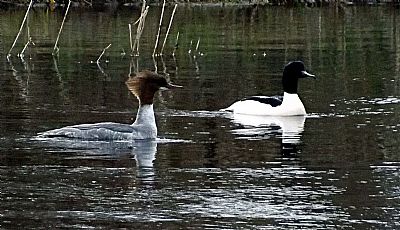
Mr and Mrs Goosander consider breakfast on the upper reaches of the Leven. Note how different they look to each other. She to the left. He to the right.
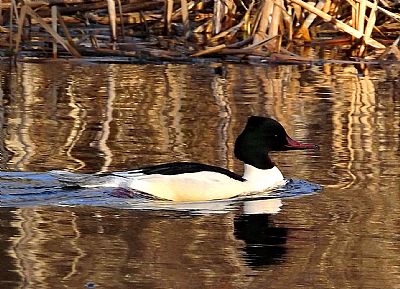
A drake on the canal at Ferrydyke, Old Kilpatrick in January.
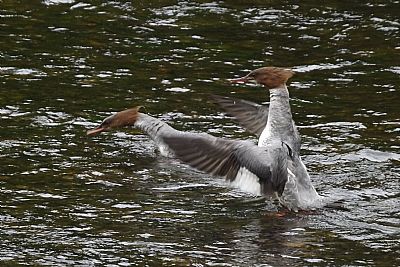
The water in the Leven is low and fish are harder to catch whether you are an angler or a goosander. Looking for an instant as though this is one bird with two heads, here two female goosanders battle it out for a small fish. The one on the left actually has it.
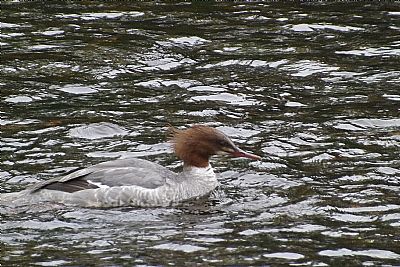
The winning female goosander goes off satisfied.
The RSPB tells us : Goosander nest in holes in trees along the riverbank. They first bred in in the UK in 1871, building up numbers in Scotland and moving south to northern England and Wales. It is now found in the South West too. The Scottish Wildlife Trust adds : Goosanders have their chicks in spring/early summer and usually have between six and seventeen.
Seeing a goosander mum with her young is a treat. They learn to paddle along behind her very soon and some will get to ride on her back.
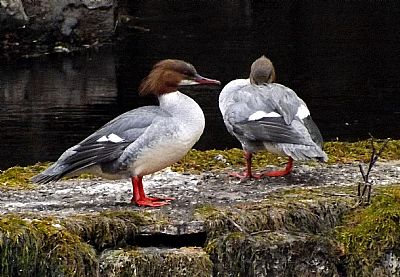
We would have expected these females to be on a nest in mid May, but three were on a rock in the Leven preening..
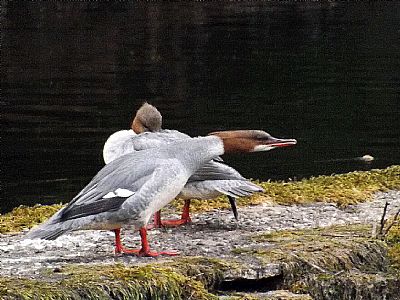
This one did some neck stretching. A fish stuck in the gullet? Or just a good stretch?
The goosanders were not seen, at least on the upper Leven, all during June 2024. It is likely that they had moved to calmer water to raise their young. So it was with some relief that they were noticed again in the second week of July.
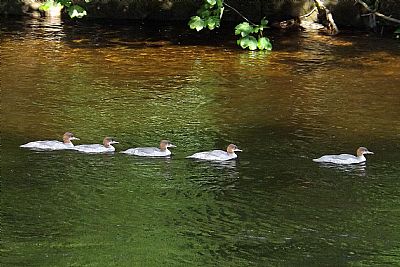
A female goosander leads what appear to be almost fully grown ducklings in a neat line down the Leven in July. At this stage male and female ducklings have the same plumage. Although small ducklings have been seen here in the past, it is likely that these were raised on calmer water, perhaps on Loch Lomond. Small ducklings can climb onto their mother's back, but this year (2023) this spectacle was missed.
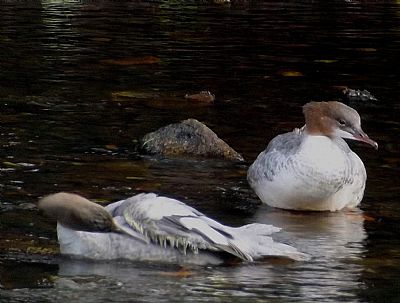
Some preening after some exhuberant hunting.
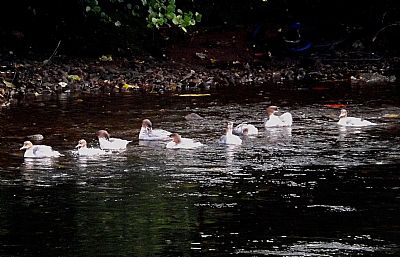
A posse of nine adolescent goosanders create happy havoc in the fast flow of the Leven in September and then gather for some relaxing preening. You may notice that all have femaie plumage. Are they all hens or simply young fully grown, but with some only getting their striking black and white male plumage in the breeding season?
The Birdwatching website gives us newly discovered insight into this mystery.
It has been discovered quite recently that Goosanders also have a moult migration, yet extraordinarily, it is confined to the males. For many years, it had been noted that the drakes were absent from their Scottish rivers from June to October or so, even where the mothers and broods were feeding, and for many years their whereabouts was a mystery.
It has now been shown that these drakes undertake a remarkable journey, travelling all the way to the North Cape of Norway. Here they mingle with 35,000 other males from other parts of western Europe and loaf about, moulting their plumage.
It is well known that ducks commonly show differential migration, with each gender exhibiting a different migratory strategy – for example male Smews remain close to the breeding grounds in winter, while in Britain, further away, we see more females and immature males.
However, for the male Goosanders to migrate such a significant distance, leaving the females behind, is of a different order of magnitude.
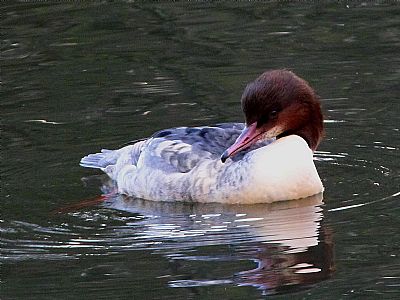
A lone goosander hen finds company amongst other species and hand-out food on a Glasgow pond in January.
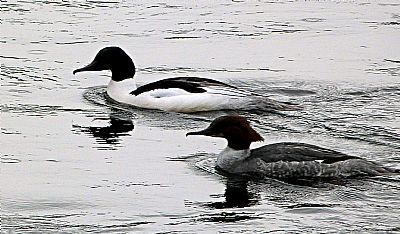
A magnificent pair on the upper Leven in mid-April. 4 pairs had been seen so far this spring.
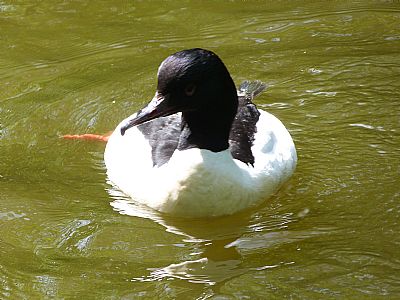
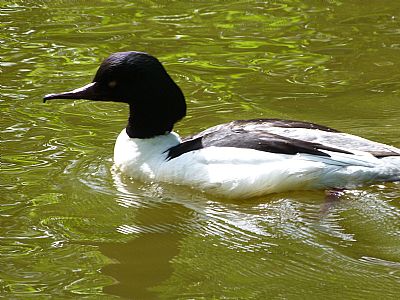
Two pics of a male goosander on a pond.
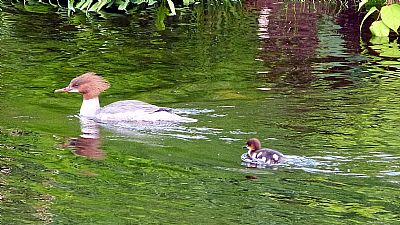
Goosander families are usually quite large. It is well into May and here we see only one duckling. A heron and a carrion crow had recently been seen hunting mallard young so it is possible this explains the low number here. This little one has a good chance of survival. It was already adept at racing ahead and then diving before rejoining Mum.
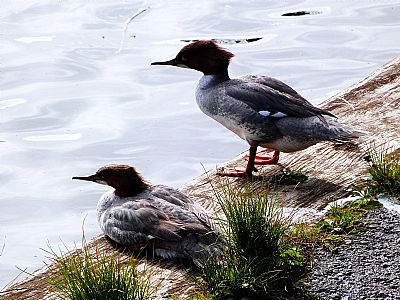
A pair of females take time out on the slipway at the barrage early one June morning.
BIRWATCHING website : https://www.birdwatching.co.uk/features/species/goosander/
BRITISH TRUST FOR ORNITHOLOGY : https://www.bto.org/develop-your-skills/bird-identification/videos/bto-bird-id-goosander-and-red-breasted-merganser
RSPB : https://www.rspb.org.uk/birds-and-wildlife/wildlife-guides/bird-a-z/goosander/
WILD SCOTLAND : https://www.wild-scotland.co.uk/wildlife-nature/birds/goosander
THE WILDLIFE TRUST : An excellent website to aid in identifying ducks : https://www.wildlifetrusts.org/wildlife/how-identify/how-identify-diving-ducks

